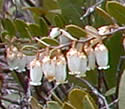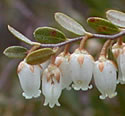Chamaedaphne calyculata (Leather-leaf)
| Also known as: | |
|---|---|
| Genus: | Chamaedaphne |
| Family: | Ericaceae (Heath) |
| Life cycle: | perennial woody |
| Origin: | native |
| Habitat: | sun; bogs, peatlands, swampy streambanks in coniferous forests |
| Bloom season: | April - June |
| Plant height: | 12 to 40 inches |
| Wetland Indicator Status: | GP: OBL MW: OBL NCNE: OBL |
| MN county distribution (click map to enlarge): |  |
| National distribution (click map to enlarge): |  |
Pick an image for a larger view. See the glossary for icon descriptions.
Detailed Information
Flower: 


![[photo of flowers]](/udata/r9ndp23q/pd/chamaedaphne-calyculata-007-t.jpg) Horizontal or arching leafy racemes of nodding, urn-shaped, pearly white bells with crisp rolled up petal lips, on a short stalk. The tubular flowers are ¼ to 1/3 inch long, wider at the top, narrowing towards the curl framed opening below. Sepals are triangular, scaly and a coppery color. A mature plant has many flowering branches.
Horizontal or arching leafy racemes of nodding, urn-shaped, pearly white bells with crisp rolled up petal lips, on a short stalk. The tubular flowers are ¼ to 1/3 inch long, wider at the top, narrowing towards the curl framed opening below. Sepals are triangular, scaly and a coppery color. A mature plant has many flowering branches.
Leaves and stem: 

![[photo of leaves]](/udata/r9ndp23q/pd/chamaedaphne-calyculata-006-t.jpg) Leaves are leathery, elongated oval or elliptical with blunt base and blunt to rounded or tapered tips, ¾ to 1½ inches long, ¼ to ½ inch wide, on a short, scaly brown stalk. Leaf edges are slightly rolled under and finely toothed. Upper surface dark green with a smooth sheen, undersides pale greenish brown with scales. Leaves in the floral raceme are reduced in size. New growth is brown, scaly and finely hairy, older branches turn gray with a fine exfoliating bark texture.
Leaves are leathery, elongated oval or elliptical with blunt base and blunt to rounded or tapered tips, ¾ to 1½ inches long, ¼ to ½ inch wide, on a short, scaly brown stalk. Leaf edges are slightly rolled under and finely toothed. Upper surface dark green with a smooth sheen, undersides pale greenish brown with scales. Leaves in the floral raceme are reduced in size. New growth is brown, scaly and finely hairy, older branches turn gray with a fine exfoliating bark texture.
Notes:
Of its three contemporary, and of similar habit, evergreen bog shrubs—Andromeda glaucophllum, Kalmia polifolia and Rhododendron groenlandicum?Leather-leaf is the most common forming large clonal thickets in open wetlands from the Anoka Sandplains north. Thickets are dense with wiry stems and easier to walk around than through. Robust in cool wet springs, leaves and flowers readily take on a scorched appearance in warm dry weather. Colonies advance by stems rooting in the damp spaghnum moss or by rhizomes. Its thickets can be of great size, often being the dominant shrub in some open wetlands but it is never invasive, sharing in a richly diverse ecosystem.Native Plant Nurseries, Restoration and Landscaping Services ↓
More photos
Photos courtesy Peter M. Dziuk, taken in open wetlands in Aitkin, Anoka and Washington counties.
Comments
Have you seen this plant in Minnesota, or have any other comments about it?
on: 2016-05-27 00:17:09
Located off the Railroad tracks between Hibbing and Nashwauk is a Coniferous bog. These leatherleafs are common there.
on: 2019-03-08 11:36:10
The flowers are attractive to bumblebees.
on: 2019-05-26 09:07:54
The bog walk is new this spring. The bog is filled with these leather-leaf blossoms and cotton grass.
on: 2019-06-02 10:05:37
Plant has largely overtaken blueberry that was once the dominant and soft-after crop.
on: 2020-04-03 21:54:30
Grows in my pond/bog, but could only view up close in the winter. Finally, I took a walk out there last week and got a picture to ID it. I'll try to view the flowers from shore now that I know.
on: 2021-05-28 20:50:32
The flower I've been looking for is Arbutis. We always found them around September when school started. They grew close to the ground, and we found that they came in pink or white. As I remember. they were hidden under an oval almost leathery leaf. They smelled divine and we always brought our teachers a bouquet. The flowers were small and finding them was the highlight of our hunt! When I say (we) I am referring to my little sister. She passed in 2000 when she was 53. When I think of Arbutis, I think of her. I miss her.
on: 2021-05-29 09:34:33
Sharyn, the plant you're looking for is Epigaea repens, trailing arbutus.







 Leather-leaf plant
Leather-leaf plant more flowers
more flowers